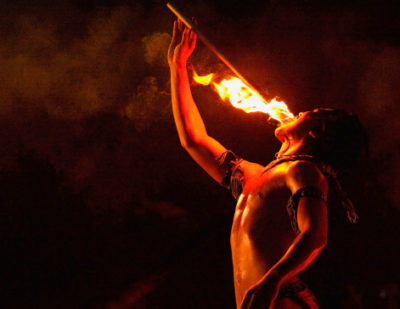Polynesian / Tahitian / Hawaiian Hula Dance Performance by SP Male Professional Dancers.
Now Available For Booking!
Hula is a Polynesian dance form accompanied by chant (oli) or song (mele, which is a cognate of Fijian language “meke”). It was developed in the Hawaiian Islands by the Polynesians who originally settled there. The hula dramatizes or portrays the words of the oli or mele in a visual dance form.
There are many sub-styles of hula, with the main two categories being Hula ‘Auana and Hula Kahiko. Ancient hula, as performed before Western encounters with Hawai?i, is called kahiko. It is accompanied by chant and traditional instruments. Hula, as it evolved under Western influence in the 19th and 20th centuries, is called ?auana (a word that means “to wander” or “drift”). It is accompanied by song and Western-influenced musical instruments such as the guitar, the ?ukulele, and the double bass.
Terminology for two main additional categories is beginning to enter the hula lexicon: “Monarchy” includes any hula which were composed and choreographed during the 19th century. During that time the influx of Western culture created significant changes in the formal Hawaiian arts, including hula. “Ai Kahiko”, meaning “in the ancient style” are those hula written in the 20th and 21st centuries that follow the stylistic protocols of the ancient hula kahiko.
There are also two main positions of a hula dance – either sitting (noho dance) or standing (luna dance). Some dances utilize both forms.
In the 1890s and early 1900s, hula dancers and Hawaiian musicians toured the U.S. mainland. This advertisement appeared in an Ohio newspaper in 1921.
Hula dancing is a complex art form, and there are many hand motions used to represent the words in a song or chant. For example, hand movements can signify aspects of nature, such as the swaying of a tree in the breeze or a wave in the ocean, or a feeling or emotion, such as fondness or yearning. Foot and hip movements often pull from a basic library of steps including the kaholo, ka’o, kawelu, hela, ‘uwehe, and ‘ami. There are other related dances (tamure, hura, ‘aparima, ‘ote’a, haka, kapa haka, poi, Fa’ataupati, Tau’olunga, and Lakalaka) that come from other Polynesian islands such as Tahiti, The Cook Islands, Samoa, Tonga and Aotearoa (New Zealand); however, the hula is unique to the Hawaiian Islands.
Today, hula is seen as a way to attract tourists to Hawai’i because of the beauty, power, and meaning behind it.

